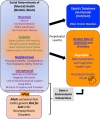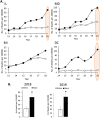The Opioid Epidemic: a Crisis Disproportionately Impacting Black Americans and Urban Communities
- PMID: 36068482
- PMCID: PMC9447354
- DOI: 10.1007/s40615-022-01384-6
The Opioid Epidemic: a Crisis Disproportionately Impacting Black Americans and Urban Communities
Abstract
The heroin epidemic has existed for decades, but a sharp rise in opioid overdose deaths (OODs) jolted the nation in the mid-twenty-teens and continues as a major health crisis to this day. Although the new wave of OODs was initially approached as a rural problem impacting a White/Caucasian demographic, surveillance records suggest severe impacts on African Americans and urban-dwelling individuals, which have been largely underreported. The focus of this report is on specific trends in OOD rates in Black and White residents in states with a significant Black urban population and declared as hotspots for OOD: (Maryland (MD), Illinois (IL), Michigan (MI), and Pennsylvania (PA)), and Washington District of Columbia (DC). We compare OODs by type of opioid, across ethnicities, across city/rural demographics, and to homicide rates using 2013-2020 data acquired from official Chief Medical Examiners' or Departments of Health (DOH) reports. With 2013 or 2014 as baseline, the OOD rate in major cities (Baltimore, Chicago, Detroit, Philadelphia) were elevated two-fold over all other regions of their respective state. In DC, Wards 7 and 8 OODs were consistently greater than other jurisdictions, until 2020 when the rate of change of OODs increased for the entire city. Ethnicity-wise, Black OOD rates exceeded White rates by four- to six-fold, with fentanyl and heroin having a disproportionate impact on Black opioid deaths. This disparity was aggravated by its intersection with the COVID-19 pandemic in 2020. African Americans and America's urban dwellers are vulnerable populations in need of social and political resources to address the ongoing opioid epidemic in under-resourced communities.
Keywords: African American; Black; Caucasian; European American; Fentanyl; Health disparity; Heroin; Homicides; Opiates; Opioid; Opioid overdose; Social Determinants of Health; Social Determinants of Mental Health.
© 2022. W. Montague Cobb-NMA Health Institute.
Conflict of interest statement
The authors declare no competing interests.
Figures









References
-
- Vital statistics rapid release: provisional drug overdose death counts [Internet]. Center for Disease Control and Prevention. 2021. Available from: https://www.cdc.gov/nchs/nvss/vsrr/drug-overdose-data.htm#selection_spec....
-
- Mericle AA, Sheridan D, Howell J, Braucht GS, Karriker-Jaffe K, Polcin DL. Sheltering in place and social distancing when the services provided are housing and social support: the COVID-19 health crisis and recovery housing. J Subst Abuse Treat. 2020;119:108094. doi: 10.1016/j.jsat.2020.108094. - DOI - PMC - PubMed
Publication types
MeSH terms
Substances
Grants and funding
LinkOut - more resources
Full Text Sources
Medical
